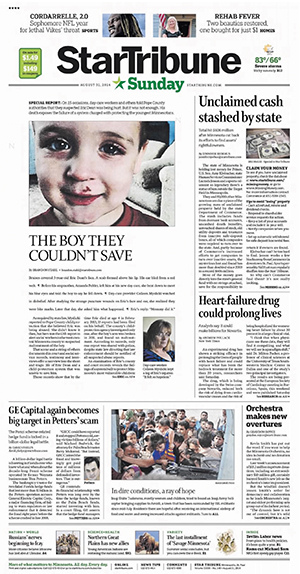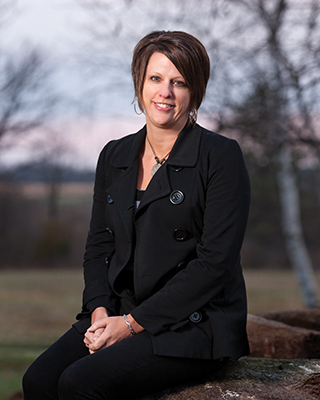Minnesota’s child welfare workforce was stressed. It was 2014, and families and communities continued to face lasting effects of the recession. The opioid crisis was escalating but still poorly understood.

Then in September, the state’s largest newspaper broke the story of a four-year-old’s death the previous year in a small town in western Minnesota, despite repeated reports to child protection. Photos of Eric Dean, bruised but smiling, got Minnesota’s attention. The governor formed the Task Force on Child Protection. Reports of child maltreatment began to rise rapidly around the state.
Hennepin County, Minnesota’s largest with 1.2 million residents, stretches from the urban skyline of Minneapolis to the farm land of St. Bonifacius. In one year, the county experienced a 37 percent child welfare staff turnover.
“It was crazy, caseloads were exorbitant,” says Janine Moore, MSW ’01, who oversees efforts toward a critical reduction of racial disparities and disproportionality in the county’s child welfare. At the time she was area director for children and family services in Hennepin County Health and Human Services.
The county ordered an internal audit of the screening and investigation process for child protection cases.
“We were trying to get a handle on the increase in cases and staff turnover and assess the opportunities for change,” says Moore. “We knew we had to do things differently.”
Seventy-five miles to the north, Kanabec County is home to 16,200. The county seat is Mora, surrounded by farms, woodlands, and wetlands. With only a handful of child welfare positions, it was regularly losing staff to counties with stronger tax bases. The children’s services career supervisor, nearing retirement, was concerned about leadership transition.
“She was a real advocate for me in continuing my education and pushing me to challenge myself in my child welfare career,” says Kristen Struss, MSW ’14, then commuting to complete classes at the U while working full time and raising her own kids.
In both Hennepin and Kanabec counties, about a quarter of the population is under 18. As the number of children involved with child protection services climbed, caseloads for child protection workers were increasing dramatically. And as a wave of professionals reached retirement age, more and more of them were opting to take it.
Staff at the University’s Center for Advanced Studies in Child Welfare (CASCW) knew from their network of students, alumni, and field supervisors that Minnesota families, children, and the workforce that provides services to them were in trouble. CASCW staff along with dedicated community partners and collaborators sounded the alarm and worked hard to address workforce needs, but the caseloads and turnover only went up.
A reliable resource
Representative Ron Kresha didn’t expect to become an expert on child protection. In 2014 the Republican from Little Falls was a member of the House early education committee in the Minnesota legislature. But when Governor Mark Dayton formed the child protection task force, Kresha was one of 26 state leaders who became involved and eventually issued 93 recommendations for child protection system reform. Later Kresha was named as co-chair of the ongoing Legislative Task Force on the Protection of Children, a legislative oversight body formed at the conclusion of the Governor’s task force. That’s when he met Traci LaLiberte.

LaLiberte is the director of CASCW in the School of Social Work. Affectionately pronounced “cashew,” the center has been a resource on child protection for 25 years. LaLiberte provided information and resources to Kresha and the taskforce about the training and education of Minnesota’s child protection workforce. She also scheduled a meeting and sat down in Kresha’s office.
“She started to go through the data with me,” Kresha remembers. “She broke it down so I could see, ‘Here’s what the data is telling me. Here’s what’s verifiable.’”
Reform efforts are often triggered by tragedy, but research shows that efforts rolled out without comprehensive analysis of contributors to a problem or effectiveness of proposed interventions not only fail but often make things worse. Kresha was committed to a thorough, data-driven analysis of problems, possible solutions, and outcomes to strive for.
Through the months ahead, Kresha came to know the energetic, professional LaLiberte and members of her staff, turning to them for reliable data and information.
Understanding the workforce
Workforce stabilization emerged as a theme of several recommendations in the 2015 task force report. But more in-depth information was needed.
Even with reasonable caseloads, child protection workers endure high stress on the job, often daily. For the most seasoned professional—calm during a visit to a hospital, school, or home—it’s not unusual to shed tears in the car or back in the office. Supportive work environments are critical. Many child protection workers came to their work, or stayed in the field once they found it, out of a deep compassion for families and children and a drive to improve lives. They know not only stress but the relief of getting a child to safety and the joy of seeing small and big changes that lead to healthier, happier families. Simply adding more layers of regulations can demoralize and even drive out the best workers.
To learn more, CASCW joined forces with the Minnesota Department of Human Services and county social service administrators to develop and conduct a child welfare workforce stabilization survey.
In February 2016, the survey was sent to 1,948 professionals like Janine Moore and Kristen Struss working as front-line staff or supervisors in child welfare—which includes child protection services, children’s mental health, foster care, adoption and permanency, and prevention and early intervention services.
“This is a societal problem, not something we can tuck away in corners and ignore.”
-Rep. Ron Kresha
Completed responses from 734 professionals working specifically in child protection showed that Minnesota’s public and tribal child protection workforce was stressed in ways that had created significant instability over the previous year—and at least a quarter of the workforce could be expected to turn over in the year ahead. Respondents said that higher salaries, lower caseloads, and fewer administrative requirements would help retain them.
The survey sponsors asked leaders to focus their efforts on providing more support for dealing with secondary traumatic stress, improving quality of supervision, fostering peer support, keeping the workforce informed of reform efforts coming up, and improving public perception of child protection work in Minnesota.
Changes
In Hennepin County, a transformation of children and youth services, specifically within child protection services, is well underway. Annual turnover has been reduced to approximately 10 percent with an ultimate goal of less than 7 percent.

Hennepin County partnered with CASCW to create an embedded field unit where MSW students from the U specializing in child welfare complete their field internship and literally navigate the gigantic system. Through a unique child protection training program called Title IV-E (see sidebar below), these MSW students work with an onsite educator—a field coordinator—to gain direct, supervised experience working with vulnerable children and families. Many Title IV-E graduates go on to become Hennepin County employees, benefiting the county with their existing knowledge and skills.
To increase support to its child protection employees, the county offers new hires supervision toward social work licensure, increased pay, and flexible work environments.
The staff is equipped for greater mobility, so it can meet with families closer to home instead of making them head downtown or to a government

center. And staff members are working more with neighborhood partners to identify at-risk homes earlier and offer a community-based response.
“Our goal is to move our first contact with a family off the porch and back to the sidewalk, well before the family finds themselves in crisis,” says Moore. “This will allow us, and community agencies as our partners, to provide preventative supports and services to families.”
Other counties also continue to make changes as child protection reform efforts roll out across the state. In Kanabec County, survey data related to salaries convinced the county to bring its pay for child protection workers into line with peers. The workforce stabilized. Struss, now children’s services supervisor, heads a team of eight, with front-line staff who rotate days on intake duty.
“We are one person to one family, full service,” says Struss, meaning intake, assessment, investigation, and case management.
Coming together
In fall 2017, the legislative task force entered its fourth year. Kresha is proud of the bipartisanship that he believes has allowed the state to make progress.
“This is a societal problem, not something we can tuck away in corners and ignore,” he says. “If we accept the fact that we’re short on workers, we can’t have a high percentage of our kids going through trauma—it’s going to hurt us down the road.”
That’s why Struss and her staff in Kanabec County get out into the community to provide education—for example, about foster care—and to maintain good relationships with the schools, hospital, faith communities, and law enforcement. Collaboration is a value taught to MSW Title IV-E students, who learn to collaborate across disciplines as well as to partner within communities to support families and ensure the safety of children.
“Let’s stop putting blame and come together as a community,” she says. Good community relationships are an outgrowth of what child protection workers do with individuals and families, case by case.
“You’re working through some hard things at the beginning, but by the end, you see some trust in this person,” says Struss. “We’ve got to celebrate those victories. They may seem small—like walking into a treatment facility—but they are victories.”

Learn more about the Center for Advanced Studies in Child Welfare and the Title IV-E Child Welfare Fellowship Program.
Story by Gayla Marty | Photos by storyblocks.com except as indicated | Winter 2018
 storyblocks.com
storyblocks.com 